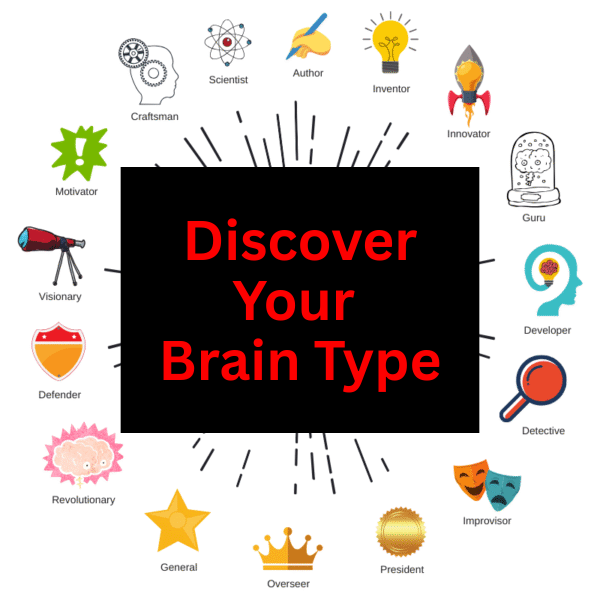 Have you heard of SMART goals? It’s a great acronym and a good system which I actually recommend for some brain types, but for others, it doesn’t work so well.
Have you heard of SMART goals? It’s a great acronym and a good system which I actually recommend for some brain types, but for others, it doesn’t work so well.
For people who want something even simpler, I’ve got just the thing.
And for the brain types who like acronyms but still don’t tend to do well with the SMART goal system, here you go:
Setting Immediate Measurable Practical Logical Emotional goals.
I just made that up, but seriously, you can see different aspects in this acronym and that’s the point I really want to make. Some people are wired for immediate instant gratification. Others are wired for measurable benchmarks. A few like a more practical system. Then some prefer their goal setting to be logical, while others are excited more by emotional triggers.
It’s all about brain types and since there are 16 different brain types, there are 16 different ways to skin this cat.
SMART goals do actually appeal to about 7 of the 16 brain types, so that system works great for lots of people, but what about the other 9 brain types? Well, this post is about a system that will appeal to most of the brain types, so it will probably work for you and those you care about, so, by all means, spread the love and send it forward to anyone you feel could also benefit!
You probably already know that more than 90% of the goals set by people fail. For some reason though, people keep trying the same techniques, or other techniques that don’t mesh with their brain wiring. I do know the reason though. It’s because they don’t know any better and don’t even realize they might be barking up the wrong tree for their brain type.
If you want to be one of the few who succeeds in accomplishing your goals (and experience less frustration along the way), versus the many that just talk and fail, you need to be crystal clear on the answers to four key questions that scientists and researchers in the field agree need to be asked:
- What’s your WHY?
- When you say your goals out loud, do they make you feel excited?
- What tools or resources do you need to achieve your goal?
- What is your plan to use those tools?
Does this sound daunting so far? If it does, your goal isn’t strong enough. You don’t want it bad enough. Or you aren’t uncomfortable enough in your present situation to be motivated to run after it. Just stop here and come back to it when you do feel strongly about it, or when you have found another goal that does get you excited enough.
If you are still with me and want to drill deeper into each of these four questions, then read on because we will get nice and specific.
Then I will lay out a plan for implementation in three simple, easy to follow steps.
What’s your WHY?
What will this goal get you? Then ask yourself what that will get you. Then keep asking this question until you run out of answers. That last answer will be either emotional or exciting beyond words. Then you have found your WHY.
It’s helpful to have someone else assist you with this by asking you “OK, and what will that get you?” (or slight variations of that, based on your answer) until you run out of answers. Try hard though, whether you are doing this alone or with someone because if you really push yourself and try to keep coming up with answers, even when you think you’re done, you will get further into the real reason why.
Here’s an example from one of my members at the X Gym (name excluded of course).
Me: So why do you want to lose weight?
Her: I’m just tired of being so frumpy.
Me: OK, what will that get you when you don’t feel that way anymore?
Her: I’ll be able to enjoy my clothes and the way I look.
Me: OK, what will that get you?
Her: More confidence.
Me: OK, what will more confidence do for you?
Her: It will help me stand tall in front of others and my kids.
Me: OK, how will that help you?
Her: My kids will see me as confident instead of ashamed.
Me: OK, why is that important to you?
Her: I always remember my mom being ashamed of her health and weight. It really affected her relationships and her confidence.
Me: OK, so if your kids saw you as different than your mom in those ways, what would that do for you?
Her: It would help them because I wouldn’t be modeling that for them like my mom did for me.
Me: OK, what would that do for you, and them?
Her: It would be easier for them to be healthy because it’s been really hard for me due to what was modeled to me by mom.
Me: OK, how would seeing them find an easier path to health make you feel?
Her: Amazing because I want to make it easy for them to be healthy. And I want to be around for them too.
Me: What would being around for them do for you?
Her: I’d get to see them grow up and have kids of their own. My mom died from complications of diabetes before they were born, so she never got to see her grandkids and they never got to see their grandma.
Then she started crying…
BOOM! There’s her WHY. It’s also the leverage I need to motivate her. She has just given me an “Away from” motivator (early death) and a couple big “Toward” motivators (to be a good example to her kids and to live to see her grandkids) to work with now, which is ideal. One or the other can be enough, but both is best.
When you get to your why, you will find that it usually involves love, or status, or both. If you don’t get to something that deeply moves you and has to do with love or status, you aren’t done with this game yet. Keep going until you get there.
When you say your goals out loud, do they make you feel excited?
Say them to yourself in the mirror. It doesn’t matter than you might not believe yourself when you say them. Ignore that part. It only matters if you feel “meh” when you say them. In that case, drop it and find a better or stronger one that makes your heart beat faster and creates a state of excitement.
If you feel something jump inside of you when you watch yourself say it (maybe even unexpectedly) then you are on the right track. It can be a gut feeling too. You might feel something in your stomach – maybe even “butterflies” – or in a flutter in your chest, but it will resonate somewhere. This will be an indicator that your goal is a strong “must have” and not just a weak wish.
What tools or resources do you need to achieve your goal?
This might be a friend who can motivate you, a certain type of trainer or group instructor, a gym, a certain piece of exercise equipment, a kitchen gadget or cookbook, a recipe site (i.e. like hardbodcafe.com), a motivation website (i.e. dietbet.com), posting a goal on your Facebook page, posting pics and vids of your journey and progress on Instagram, etc.
If you still feel stumped, this is where my Brain Type Test can come in handy. Just go to beegeandpeege.com/discover-your-brain-type/ and fill out the easy 20 question form. You will get a report back that recommends several resources that will make sense to your individual brain wiring. Look! Another tool already! See, this will be easier than you thought.
What is your plan to use those tools?
Without a plan, your goal will remain a pipe dream. The old saying is true: “Failing to plan is planning to fail.” Most people make their resolution and somehow think it will just magically happen because they thought it into existence. Last I checked, that’s only possible for God, so the rest of us need to do more than that. The rest of this article will help with this step, so keep reading and you will come up with that plan.
Now if you’ve answered the four primary questions above, you’re ready to get started with the three simple steps below.
First, put it to paper. The act of writing your goal with a pen or pencil flips a switch in your brain that makes it more real to your subconscious. This is important because getting your subconscious on board is even more important than your conscious brain.
In fact, even if your conscious brain doesn’t believe your goal is possible, but your subconscious does, your chances of success are still fantastic. Your subconscious brain is the boss of you and it’s much more powerful than your conscious brain, so getting it on your side is vital to your success.
When people make a resolution, they say it with their conscious brain, but usually do nothing to drive it into their subconscious. The result is they end up reverting back to the status quo – because that’s what the subconscious is good at – and then change never happens, or it’s temporary and they yo-yo in their results. Or it feels like too much work because the stronger subconscious is fighting against the weaker conscious brain and it will win that fight every time.
Images and emotions are the best ways to begin to get your message across to the subconscious and putting pen to paper is the first step in that process. Writing it on a computer or another electronic device won’t cut it, so even if you do that first to capture your thoughts, be sure to hand write it on paper for your final version.
Write your goal so it’s concise, clear, simple and stirs your emotions. This could be excitement, love, joy, the feeling of a status change, or more. It should be worded to motivate and inspire you.
Just doing this first step sets you apart from the 97% of Americans who don’t write their goals down on paper.
Second, post your piece of paper in a place where you will see it every day. Most people post it on their bathroom mirror, but some post it on the fridge and some in the car, or they make it their phone background. More than one place is a good idea or all of the above! Pretend that you are OCD (or if you are, use that to your advantage) because the more you see it, the more you are immersed in the process.
Third, speak it out loud every day to yourself in the mirror. Now you know why I recommended making it concise – so it’s easy to do this step every day.
When you speak it, do so emphatically, with passion, imagining that it has already happened. You are that person in your imagination now, as you are speaking it. Now the mental images you are creating will get through the conscious/subconscious brain barrier faster and easier.
You can fake it too and your subconscious won’t know it. Be an “over-actor” if your conscious brain doesn’t believe what you are saying. Your subconscious operates at about the level of a three-year-old, so whatever works on a toddler will work on your subconscious. It’s really not that clever and it responds to images and emotions better than anything. That’s why really good kids’ plays and the best children’s TV shows are full of “over-actors.”
Now after doing these three simple steps, you have distinguished yourself among less than 1% of Americans who are like you. And their success rate is so high it’s astonishing.
Most people just don’t take the importance of goals seriously. They might think they are, but their subconscious hasn’t bought in because they don’t know it needs to, or they don’t know how to make that happen.
Lastly, another reason people don’t set goals (and in some cases, the most important reason of all) is the fear of failure. Don’t expect perfection. Simply strive for consistent progress. People only get disappointed in themselves or someone else if an expectation hasn’t been met. Expect progress and set that as your benchmark instead of perfection. It’s referred to as “The way of the Samurai” – to simply get a little better every day. Leaps forward are great and steps backward are inevitable since you’re human, but as long as progress is your goal, your chances of success are virtually assured.
These are “Cliff Notes” to make it easy for the people who might find this on the internet, but if you want coaching with more specifics, we do that! Just email p@bandp.life for more information.
P.S. For those of you who would like to see some of the science behind this stuff, check out this article for just one of the many examples. Or, for more fitness, health, and mindset articles, visit X Gym’s article page.









